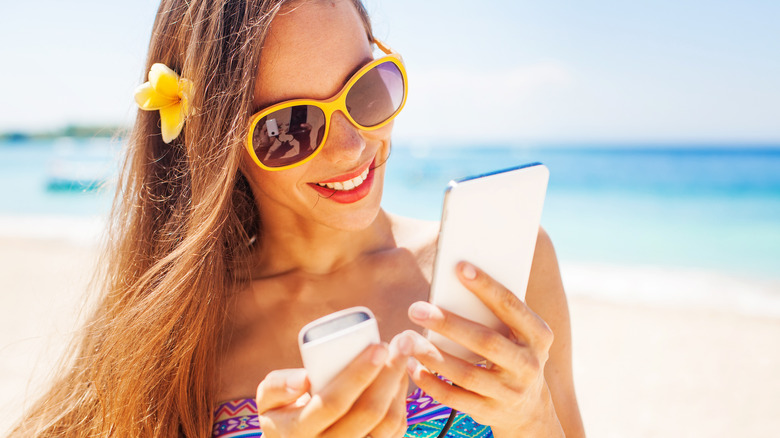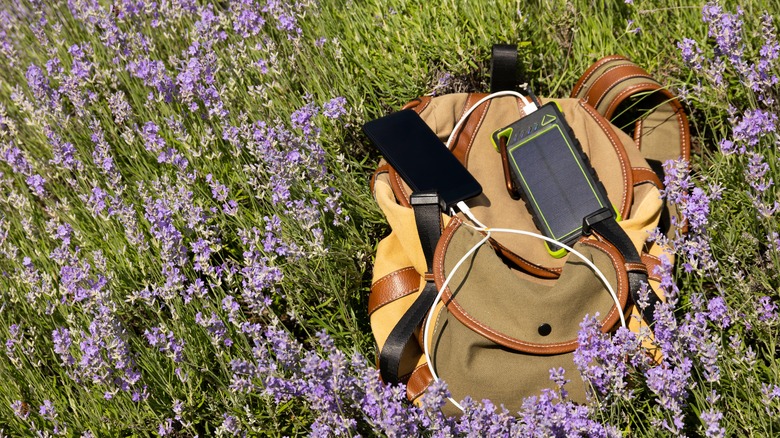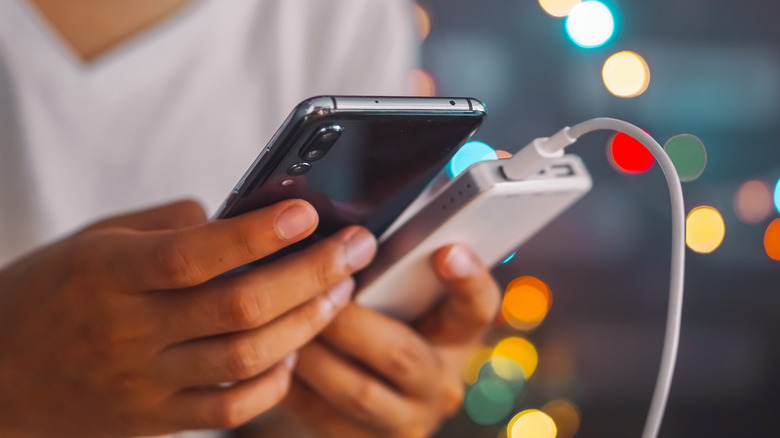Here's Why You Should Never Forget To Bring A Portable Charger When Traveling
Isn't it sometimes the case that we forget something important when we travel? A survey conducted by OnePoll for DoorDash found that 39% of the 2,000 Americans they surveyed leave behind more than five essential travel items in a month, the New York Post reports. The top three most forgotten items are cell phones (31%), water bottles or drinks (28%), and important health and beauty products (25%).
Although not in the survey, another oft-forgotten travel essential is a portable charger or power bank. Along with earbuds, flight attendants list portable chargers as a top item that passengers frequently leave behind when they fly, per Washington Post.
A portable charger is basically a travel-sized power bank that can fuel your phone, tablet, laptop, and other devices during a flight or while you're on the go. It's especially useful when you can't find an outlet to plug your normal charger in, you're outdoors, or simply forgot to bring one with you on the road.
Why bring a portable charger
The main reason you should bring a power bank is to be able to charge your devices whenever and wherever you need to. This could be in the airport while waiting to embark, during a road trip or in a car ride, on the beach, or on a flight. Like phones, portable chargers have become a necessity for modern travelers who need to keep the power on their devices for important tasks, such as pulling up vital flight info or documents (such as boarding passes), researching your destination, using a map, or communicating with family.
During a flight, for instance, a power bank is a convenient option to charge your devices, as not all airlines or planes feature a USB outlet or an in-seat plug. Southwest doesn't include charging outlets in their planes, while Alaska Air offers both a USB port and a power outlet on every seat, although it warns passengers that "there is a chance that your aircraft may not have available or adequate in-seat electrical power for your device." You'll need to ask your airline about charging availability on your flight to be sure, but your safest option is still to bring a portable charger, just in case there's no port or outlet available.
How to pick the best portable charger for you
You'll, of course, need a power bank that's reliable and able to charge your devices several times before going empty. There are plenty of good options on the market today, but which one suits your needs best will depend on your budget, travel style, and charging requirements. Here are some factors you'll need to consider before deciding on a portable charger.
First, consider how much power can it store. Portable charger descriptions include its capacity listed in mAh (milliampere hour). Tom's Guide recommends going for a power bank that can store a minimum of 10,000 mAh, adding that you'll need at least 5,000 mAh additional capacity for every other device you need recharging.
Next, consider whether fast charging is important to you. You don't want to be stuck idle for a very long time while waiting for your phone to recharge, so look for portable chargers with the Power Delivery (PD) standard. This technology allows your phone to recharge quickly, i.e., it's fast charging, but only works on USB-C ports typically found in devices from Apple and Samsung. Alternatively, look for Qualcomm's Quick Charge technology that can charge supported phones to 50% in 30 minutes.
Next, consider how compact it is. Think about how you're going to travel around with your portable charger. Some can fit inside your pocket but others will have to be stored in your carry-on bag.
And finally, can you bring it on your flight? The FAA specifies that passengers carry on lithium-ion portable chargers and power banks not exceeding 100 watt hours (or 27,000 mAh). Those that don't fit this criteria need to be in your checked baggage.


